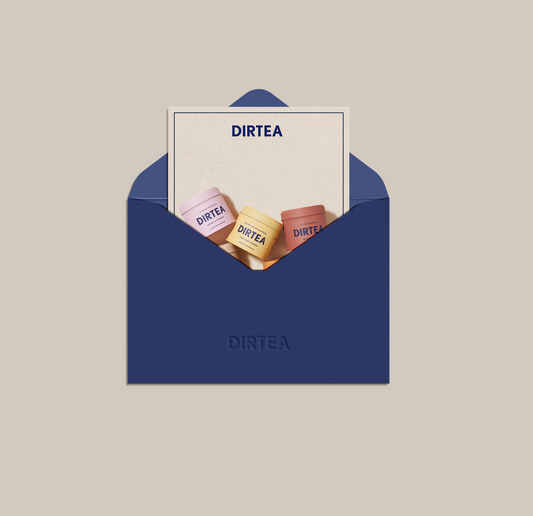How to Be Happier, Naturally: How Functional Foods Influence Serotonin and Calm

Share
Feeling “off” isn’t always about willpower. Often, it’s about inputs. The foods and drinks we choose send chemical signals through our gut and up to the brain—shaping mood, focus and a felt sense of calm. In this guide, we’ll unpack how serotonin really works, how the gut-brain axis connects your plate to your peace, which mood-boosting foods deserve space in your routine, and where adaptogenic calm drinks (like DIRTEA rituals) can fit.
Serotonin 101: A mood messenger you influence daily
Serotonin helps regulate mood, sleep, appetite and more. Although it’s famous as a “brain chemical,” most serotonin is actually made in the gut by specialised enterochromaffin cells before participating in local signalling that can influence the brain via neural, hormonal and immune routes (more on that in a second). Research suggests the gut provides around 95% of total body serotonin—a useful reminder that mood isn’t only “in the head.”
Why diet matters for serotonin
- Precursors and cofactors: Nutrients like tryptophan, B-vitamins and magnesium help support serotonin production
- Microbial metabolites: Gut bacteria turn fibre into compounds that influence serotonin activity, linking what we eat to how we feel.
The gut-brain axis: The “fast lane” between plate and mood
The gut and brain talk all day via the vagus nerve, immune messengers, hormones and microbial metabolites. Research shows the microbiota–gut–brain axis can shape stress responses, mood and cognition. Notably, gut microbes can produce or stimulate neurotransmitters (including serotonin, dopamine and GABA), highlighting multiple, diet-tunable pathways between what you eat and how you feel.
For example, fibres and polyphenols feed beneficial microbes; in turn, these microbes generate metabolites that can modulate gut peptides and local serotonin synthesis—signals that travel along the vagus nerve and other routes to affect brain function and emotion regulation.
Mood-boosting foods: What to prioritise
Below is a practical overview. Think pattern over perfection—consistency counts more than any single snack.
1) Fibre-rich plants for a happier microbiome
Aim for: Vegetables, fruits, legumes, whole grains, nuts and seeds.
Why: Diverse fibres feed microbial diversity and increase short-chain fatty acids, which play roles in gut lining integrity, inflammation balance and local serotonin signalling. These shifts are core to the gut-brain axis.
2) Fermented foods for “live” support
Aim for: Yoghurt with live cultures, kefir, sauerkraut, kimchi, tempeh.
Why: Live microbes plus fermentation by-products may support gut-brain communication. While mechanisms are still being mapped, dietary patterns that include fermented foods can complement a fibre-forward base.
3) Omega-3s for membrane and mood
Aim for: Oily fish (salmon, sardines, mackerel) 1–2×/week, or algae-based omega-3s.
Why: Omega-3 fatty acids integrate into neuronal membranes and may support brain signalling. They also interact with the gut-immune axis, which can influence mood tone and stress resilience.
4) Polyphenol-rich plants for anti-stress signalling
Aim for: Colourful berries, cocoa, green tea, extra-virgin olive oil, herbs/spices.
Why: Polyphenols may act as prebiotics for beneficial microbes and support oxidative-stress balance. In drinks, cocoa and green tea also deliver feel-good ritual value—an under-rated lever for calm.
5) Tryptophan-containing foods (with balance)
Aim for: Eggs, dairy, turkey, tofu, soy yoghurt, pumpkin seeds, oats.
Why: Tryptophan is a serotonin precursor. You don’t need heroic doses—just consistent inclusion within balanced meals that also provide B-vitamins and minerals involved in neurotransmitter pathways.
6) B-vitamins & magnesium as quiet enablers
Aim for: Whole grains, greens, legumes, nuts, seeds; consider fortified options.
Why: B-vitamins and magnesium help enzymes involved in energy and neurotransmitter metabolism. In DIRTEA products, selected blends include B vitamins.
Adaptogenic Calm Drinks: Rituals That Support Your Nervous System
Adaptogenic drinks offer two wins: bioactive support and a soothing ritual that signals calm to your nervous system. With DIRTEA’s blends, you can turn each moment into a mindful practice backed by nature and science.
Morning Balance with DIRTEA Matcha (Focus + Calm Energy)
Start your day with DIRTEA Mushroom Matcha — a clean energy ritual that blends ceremonial-grade matcha, Lion’s Mane mushroom extract, and an organic B-vitamin complex (including B5, B6, Biotin and B12).
Together, these help support normal psychological function, reduce tiredness, and deliver what many call “calm focus.” Matcha’s natural L-theanine tempers caffeine’s edge, making this drink perfect for mindful mornings when you want energy without the crash.
Evening Wind-Down with DIRTEA Cacao (Reishi + Calm)
For your nightly ritual, reach for DIRTEA Cacao — a velvety, sugar-free hot chocolate infused with Reishi mushroom and organic Vitamin B12.
This ancient adaptogen is traditionally used to support relaxation and immune function, while cacao’s natural flavanols promote feel-good calm and comfort.
Sipping this before bed creates a wind-down signal for your body and mind, helping you transition from high-stimulus evenings into deeper rest.
Tip: Pair it with soft lighting and a screen-free hour to reinforce your circadian rhythm and improve sleep quality.
The DIRTEA Ritual: Mindful Moments, Modern Calm
Whether it’s the Matcha in the morning or Cacao in the evening, DIRTEA’s adaptogenic drinks turn functional nutrition into daily mood support. Each blend is dual-extracted, 0 sugar, third-party tested, and vegan, making it a clean and effective way to feed your gut-brain axis from both sides of the day.
Does diet really change mood? Emerging clinical evidence
In the 12-week SMILES trial, adults with major depression who followed a Mediterranean-style diet saw far greater symptom improvement than the control group, with 32.3% achieving remission versus 8%. This doesn’t replace standard treatment, but it shows nutrition can play a meaningful role in supporting mood.
A simple “happy-gut” day plan
Morning (Focus & calm):
- Breakfast: Greek yoghurt (live cultures) with oats, chia, berries and a drizzle of extra-virgin olive oil.
- Ritual: Matcha with a mindful sip routine (inhale for 4, exhale for 6), benefiting from L-theanine’s calm-focus profile.
Mid-day (Stable energy):
Lunch: Lentil-and-veg bowl with leafy greens, roasted peppers, pumpkin seeds, and a tahini-lemon dressing; add salmon or tofu.
Walk: 10–15 minutes outside to nudge circadian rhythm and stress relief.
Afternoon (Avoid the slump):
- Snack: A small handful of walnuts and an apple, or hummus with carrots.
- Micro-break: 2 minutes of slow breathing to down-regulate.
Evening (Wind-down):
- Dinner: Mediterranean-style: whole-grain base + colourful veg + oily fish/legume protein + herbs and olive oil.
- Ritual: A warm cacao-based adaptogenic calm drink; lights dimmed, no screens 60 minutes before bed.
Troubleshooting your mood-nutrition routine
- “I eat well but still feel anxious.” Nutrition helps, but it’s one pillar. Sleep, light exposure, movement, and community matter. If symptoms persist, talk to your GP or a qualified professional.
- “Ferments upset my stomach.” Start low, go slow. Try small servings, rotate varieties, or focus on fibre-rich plants first.
- “Coffee makes me edgy.” Swap one coffee for matcha (L-theanine + lower caffeine feel).
- “I want quick wins.” Anchor two daily rituals: a morning focus drink and an evening calm drink. Then build meals around plants, protein and olive oil.
Final thoughts
“Happiness” isn’t a single lever—it’s a daily choreography of inputs that gently steer your physiology. The evidence linking diet quality, the gut-brain axis and mood is growing; functional foods and adaptogenic calm drinks are practical tools to make your routine feel better, not just look better on paper. Start with two anchor rituals, build colourful, fibre-forward plates, and let small, repeatable habits do the heavy lifting over time.
FAQs
1) Can food “boost serotonin” in the brain directly?
Not directly—serotonin made in the gut doesn’t cross the blood–brain barrier. But diet shapes precursors, cofactors and gut signalling that can indirectly influence mood pathways.
2) Are fermented foods essential?
Not essential, but often helpful. If you’re sensitive, start with small servings or prioritise fibre diversity first.
3) Is matcha better than coffee for calm?
Different, not “better.” Matcha contains L-theanine, which in clinical research supports stress-related symptoms and a calm-focus feel. If coffee makes you jittery, try replacing one cup with matcha.
4) How long until I notice changes?
Some people feel ritual-level benefits (e.g., calmer evenings) within days. Diet-quality shifts for mood can build over weeks—remember the 12-week SMILES trial framework.
References
- Appleton, J. (2018). The gut-brain axis: Influence of microbiota on mood and mental health. Integrative Medicine (Encinitas), 17(4), 28–32. https://pmc.ncbi.nlm.nih.gov/articles/PMC6469458/
- Loh, J. S., Mak, W. Q., Tan, L. K. S., Ng, C. X., Chan, H. H., Yeow, S. H., Foo, J. B., Ong, Y. S., How, C. W., & Khaw, K. Y. (2024). Microbiota–gut–brain axis and its therapeutic applications in neurodegenerative diseases. Signal Transduction and Targeted Therapy, 9, Article 37. https://www.nature.com/articles/s41392-024-01743-1
-
Jacka, F. N., O’Neil, A., Opie, R., Itsiopoulos, C., Cotton, S., Mohebbi, M., Castle, D., Dash, S., Mihalopoulos, C., Chatterton, M. L., Brazionis, L., Dean, O. M., Hodge, A. M., & Berk, M. (2017). A randomised controlled trial of dietary improvement for adults with major depression (the ‘SMILES’ trial). BMC Medicine, 15, Article 23. https://doi.org/10.1186/s12916-017-0791-y














